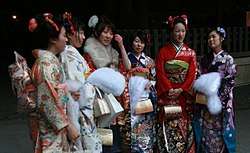Coming of Age Day
| Coming of Age Day | |
|---|---|
 | |
| Observed by | Japan |
| Type | National |
| Significance | Congratulates and encourages all those who have reached the age of maturity (20 years old) over the past year and celebrates adulthood |
| Date | Second Monday in January |
| 2017 date | January 9 |
| 2018 date | January 8 |
| 2019 date | January 14 |
| 2020 date | January 13 |
| Frequency | annual |
Coming of Age Day (成人の日 Seijin no Hi) is a Japanese holiday held annually on the second Monday of January. It is held in order to congratulate and encourage all those who have reached the age of majority over the past year, and to help them realize that they have become adults. Festivities include coming of age ceremonies (成人式 seijin-shiki) held at local and prefectural offices, as well as after-parties among family and friends.
History
Coming of age ceremonies have been celebrated in Japan since at least 714 AD, when a young prince donned new robes and a hairstyle to mark his passage into adulthood.[1] The holiday was first established in 1948, to be held every year on January 15.[2] In 2000, as a result of the Happy Monday System, Coming of Age Day was changed to the second Monday in January.[1][3][4]
Japan's low birth rate and shrinking percentage of young people, coupled with disruptions to some ceremonies in recent years (such as an incident in Naha in 2002, when drunken Japanese youths tried to disrupt the festivities) and a general increase in the number of 20-year-olds who do not feel themselves to be adults have led to decreased attendance of the ceremonies, which has caused some concern among older Japanese.[5] In 2012, the decline continued for the fifth year in a row, with the total of 1.22 million adults celebrating the holiday in 2012 – under half of the participants seen at its peak in 1976, when 2.76 million adults attended ceremonies. This was the first time it has declined below the 50% threshold.[6] Japan lowered the age of adulthood in 2018 from 20 years of age to 18 which is set to take effect in 2022. This change has caused confusion on the status of the holiday, and raised concerns among the kimono industry which profits from the garments worn during the ceremonies.[7]
Ceremonies
Coming of age ceremonies (成人式 Seijin-shiki) mark one's coming of age (age of maturity), which reflects both the expanded rights but also increased responsibilities expected of new adults. The ceremonies are generally held in the morning at local city offices throughout Japan. All young adults who turned or will turn 20 between April 2 of the previous year and April 1 of the current one and who maintain residency in the area are invited to attend. Government officials give speeches, and small presents are handed out to the newly recognized adults.
Many women celebrate this day by wearing furisode, a style of kimono with long sleeves that hang down, and zōri sandals. Since most are unable to put on a kimono by themselves due to the intricacies involved, many choose to visit a beauty salon to dress and to set their hair. A full set of formal clothing is expensive, so it is usually either borrowed from a relative or rented rather than bought especially for the occasion. Men sometimes also wear traditional dress (e.g. dark kimono with hakama), but nowadays many men wear formal Western clothes such as a suit and tie more often than the traditional hakama.[8] After the ceremony, the young adults often celebrate in groups by going to parties or going out drinking.[1]
See also
References
- 1 2 3 Allen, David; Sumida, Chiyomi (January 9, 2004). "Coming of Age Day, a big event for Japanese youths, is steeped in tradition". Stars and Stripes.
- ↑ Araiso, Yoshiyuki (1988). Currents: 100 essential expressions for understanding changing Japan. Japan Echo Inc. in cooperation with the Foreign Press Center. p. 150. ISBN 978-4-915226-03-8.
- ↑ Kyōkai, Nihon Rōdō (2000). Japan labor bulletin, Volume 39. Japan Institute of Labour. p. 3.
- ↑ Glum, Julia (11 January 2015). "Japan Coming Of Age Day 2015: Facts About Japanese Holiday Celebrating Young People [PHOTOS]". International Business Times.
- ↑ Joyce, Colin (January 15, 2002). "Drunken Japanese youths ruin coming of age rituals". The Daily Telegraph.
- ↑ "Record-low number of new adults mark Coming-of-Age Day". Mainichi Daily News. January 9, 2012. Archived from the original on January 9, 2012.
- ↑ Justin McCurry (June 14, 2018). "Credit cards, but no sake: Japan lowers age of adulthood from 20 to 18". The Guardian. Retrieved June 14, 2018.
- ↑ Robertson, Jennifer Ellen (2005). A companion to the anthropology of Japan. Wiley-Blackwell. p. 158. ISBN 978-0-631-22955-1.